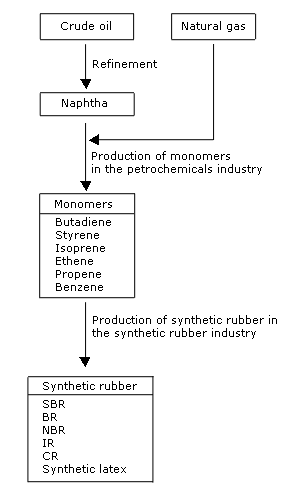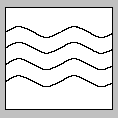| Synthetic rubber Version 1.0.0.05 |
[German version] |
Table of contents |
|
| General: | ||
| Product information | ||
| Packaging | ||
| Transport | ||
| Container transport | ||
| Cargo securing | ||
Product information
Product name
| German | Synthesekautschuk |
| English | Synthetic rubber (man-made rubber) |
| French | Caoutchouc artificiel (synthétique) |
| Spanish | Caucho syntético |
| CN/HS number * | 4002 ff. |
(* EU Combined Nomenclature/Harmonized System)
Product description
Rubber is a collective term for macromolecular substances of natural (natural rubber – NR) or synthetic origin (synthetic rubber – SR).
There were a number of reasons responsible for the development of an alternative or substitute for natural rubber. These included volatile or rising prices for natural rubber on the world market in response to the general state of the economy, political events which cut customers off from the suppliers of raw materials, long transport distances, regional constraints with respect to establishing rubber plantations and the increase in global demand for rubber.
Synthetic rubber is a white, crumbly, plastic mass which can be processed and vulcanized in the same way as natural rubber.
Synthetic rubber is produced in different ways. Figure 1 illustrates one of the common production processes.

Figure 1: Production process for synthetic rubber
Synthetic rubbers are artificially produced materials with properties similar to natural rubber. Most are obtained by polymerization or polycondensation of unsaturated monomers. A wide range of different synthetic rubbers have emerged, reflecting the various different applications and the chemical and mechanical properties they require. Co-polymerization of different monomers allows the material properties to be varied across a wide range.
Polymerization can take place under hot or cold conditions, which result in hot polymers (hot rubber) or cold polymers (cold rubber).
Synthetic rubbers are marketed as compressed bales and square blocks. They are also produced in the form of powder rubber, talcum-coated chips, granules and as latex concentrates in liquid form.
Quality/Duration of storage
The benefits compared with natural rubber include better oil and temperature resistance and the possibility of a product with an extremely constant quality. Synthetic rubbers made from butadiene (polybutadiene copolymers) rank as the most important synthetic rubbers produced.
The following list indicates some of the most important synthetic rubbers along with their properties in comparison with natural rubber.
| Styrene butadiene rubber (SBR) | |
| General purpose rubber made up of different types; better abrasion resistance, lower elasticity, poorer low-temperature behavior, better heat and aging resistance, excellent electrical insulation material similar to rubber | |
| Polybutadiene rubber (BR) | |
| Poor processing properties mean that BR is not used on its own, blended with SBR or NR, abrasion-resistant, good elasticity, flexible at low temperatures. | |
| Isoprene rubber (IR) | |
| Properties largely comparable with natural rubber, more uniform, cleaner, transparent. | |
| Acrylonitrile butadiene rubber (NBR) | |
| Oil and fuel resistant, good heat distortion temperature properties, abrasion resistant. | |
| Chloroprene rubber (CR) | |
| Flame retardant, resistant to grease, oil, weathering and aging, abrasion resistant. | |
| Butyl rubber (IIR) | |
| Low permeability to gases, resistant to aging, ozone and chemicals, good mechanical properties, abrasion resistant, good electrical insulation properties. | |
The mechanical properties are improved by adding fillers such as carbon black during vulcanization with sulfur. Temperature resistance, abrasion resistance, aging resistance, resistance to oxygen and chemicals such as acids and petrol are properties which are improved in this way.
Duration of storage varies depending on the type of synthetic rubber. For example, a range of 6 – 36 months if the ideal conditions recommended by the manufacturer, such as a storage temperature between 10 and 25°C, are observed. Synthetic rubber must be stowed dry, some synthetic rubbers must be stored cool and they are to be protected from direct sunlight. [75]
Recommended storage duration for synthetic rubber, in particular SBR [72]
| Initial storage | 5 years |
| Extended storage | 2 years |
Intended use
Like natural rubber, synthetic rubber has a wide range of applications, such as in the tire industry (car, aircraft and bicycle tires), drive belts, hoses, medical equipment, seals, floor coverings, conveyor belts, molded parts.
The following list shows the operating temperatures and applications for some important types of synthetic rubber.
| Styrene butadiene rubber (SBR) | ||
| -40 – 100°C | ||
| Tire industry (treads and carcasses), conveyor belts, seals, technical rubber products | ||
| Polybutadiene rubber (BR) | ||
| -80 – 90°C | ||
| Tires, conveyor belts, clutches, engine bearings, technical products of all types, drinking water seals | ||
| Isoprene rubber (IR) | ||
| -40 – 130°C | ||
| Technical products of all types, especially construction sections, cooling and heating hoses for vehicles, high-performance tires, foodstuffs utensils | ||
| Acrylonitrile butadiene rubber (NBR) | ||
| Operating temperature: up to approx. 110°C | ||
| Motor vehicle parts, oil and fuel hoses, technical products of all types, plates and mats, rollers, seals and for foodstuffs such as milk | ||
| Chloroprene rubber (CR) | ||
| -40 – 110°C | ||
| Conveyor belts, clutches, drive belts, technical products of all types, pneumatic suspension systems, cables | ||
| Butyl rubber (IIR) | ||
| -40 – 150°C | ||
| Automotive hoses, tire inner liners, seals, membranes, rubberized fabrics, steam hoses, cable insulation | ||
Countries of origin
All industrial nations.
Back to beginning
Packaging
| The bales (e.g. 20 – 30 kg) are wrapped in plastic sheeting (e.g. polyethylene) or in boxes lined with polyethylene. Bales are unitized in crates on pallets or with a shrink cover, for instance. | |
| Powder rubbers are packed in paper sacks or cardboard boxes lined with polyethylene and palletized. Flexible bulk packages (IBCs, e.g. 500 kg big bags) are also used as packaging. | |
| Granulated synthetic rubber is packed in polyethylene sacks and palletized. The polyethylene sacks can additionally be packed in cardboard boxes and then palletized. Flexible bulk packages (IBCs, e.g. 500 kg big bags) can also be used as packaging. | |
When wooden packaging containers or cargo securing materials are used, it may, under certain circumstances, be necessary to comply with the quarantine regulations of the country of destination (Import regulations for packaging containers made from solid wood – IPPC standard) and a phytosanitary certificate may have to be enclosed with the shipping documents. Information may be obtained from the phytosanitary authorities of the countries concerned.
| Marking of packages | ||
 Keep dry |
 Top |
 Keep away from heat (solar radiation) |
Back to beginning
Transport
Symbols
 General cargo |

Liquid cargo (latex concentrates) |
Means of transport
Ship, truck, railroad
Container transport
Standard containers subject to compliance with specifications for water content of goods and packaging. Ideal conditions would be provided by insulated containers or open-sided containers in well ventilated lower holds (protection from solar radiation and temperature variations).
Tank containers for rubber in liquid form.
Cargo handling
Protection against sharp-edged objects. The cargo should not be handled if it is raining or snowing.
Stowage space requirements
For maritime transport, synthetic rubber should preferably be stowed below deck. The holds/containers must be dry, clean and dust-free. Do not stow near heat sources.
Segregation
Fiber rope, thin fiber nets, markings.
Cargo securing
Because of its considerable impact- and pressure-sensitivity, packages of this cargo must be secured in such a way that they are prevented from damaging each other. Spaces between packages or pallets must be filled, to prevent slippage or tipping. By selecting the correct packaging size or cargo unit (area module or area module multiple), holds can be tightly loaded (without spaces).
Back to beginning
Risk factors and loss prevention
RF Temperature
Synthetic rubber requires particular temperature, humidity/moisture and possibly ventilation conditions (SC VI) (storage climate conditions).
| Term | Temperature range | Source |
| Travel temperature range | 5 – 30°C | [1] |
Synthetic rubber withstands temperatures of up to 30°C. When this temperature is exceeded, cold flow starts. The rubber begins to flow and ruptures the wrapping. The material begins to stick or combine with the packaging. Further consequences of excessive temperatures are softening and artificial aging, combined with hardening. In this event, the recipient has to pick over the blocks in a separate operation.
If the exposure to sunlight is of longer duration, oxidative cross-linking occurs on the surface of the rubber even at temperatures of 10 – 20°C (premature aging). UV radiation also causes this degradation.
The temperature threshold for transportation is 5°C; the rubber crystallizes at -15°C. This process is irreversible in synthetic rubber, which means that it becomes unusable.
Back to beginning
RF Humidity/Moisture
Synthetic rubber requires particular temperature, humidity/moisture and possibly ventilation conditions (SC VI) (storage climate conditions).
| Term | Humidity/water content | Source |
| Relative humidity | 65 % | [1] |
| Water content | 0.2…0.4 % | [1] |
| Critical water content | 0.75 % | [1] |
| Maximum equilibrium moisture content | 65% | [1] |
The water content of synthetic rubber is 0.2 – 0.4%, and synthetic rubber with a low water content thus belongs to water content class 1 (WCC 1)(water content classes).
Despite its low water content, synthetic rubber is very sensitive to moisture/humidity. The critical water content within the wrapping is 0.75%.
The bales are wrapped in heat-sealed foils and must not be damaged. If moisture penetrates, the bales soak it up like a sponge, with the result that expensive additional operations are required or the material can no longer be approved for processing in certain machines. If water bubbles can be seen inside the wrapper, the goods may have been damaged.
65 % relative humidity is recommended by the manufacturer.
Back to beginning
RF Ventilation
Synthetic rubber requires particular temperature, humidity/moisture and possibly ventilation conditions (SC VI) (storage climate conditions).
If the rubber is dry for shipment or container dry, there is no need for ventilation.
Back to beginning
RF Biotic activity
Synthetic rubber displays 3rd order biotic activity (BA 3).
Due to their processing, synthetic rubbers are goods in which respiration processes are suspended, but in which biochemical, microbial and other decomposition processes still proceed; they thus exhibit 3rd order biotic activity (BA 3).
Back to beginning
RF Gases
This risk factor has no major influence on transportation of this product.
Back to beginning
RF Self-heating/Spontaneous combustion
Synthetic rubber is highly flammable. If an upper temperature of 320°C is exceeded, it also tends to ignite spontaneously and generates considerable quantities of smoke while burning.
The fire is best extinguished with C02, not with water or foam.
Smoking is absolutely prohibited.
If there is a risk of fire, the firefighting personnel should wear automatic breathing apparatus and protective clothing.
Back to beginning
RF Odor
| Active behavior | Despite the packaging, a rubber-like smell is to be expected, so synthetic rubber must not be stowed with foodstuffs, semiluxury items and animal feedstuffs. |
| Passive behavior | Non-odor-sensitive. |
Back to beginning
RF Contamination
| Active behavior | Does not cause contamination. |
| Passive behavior | Damaged films allow the raw material to become contaminated with foreign bodies, such as dust, chemicals, metal filings, jute fibers etc. This considerably reduces the quality and can cause high processing costs or render the material completely unusable. |
Back to beginning
RF Mechanical influences
Rubber should be stowed in such a way as to avoid the risk of crushing.
The bales are wrapped in heat-sealed foils and must not be damaged. Use no hooks
Back to beginning
RF Toxicity/Hazards to health
This risk factor has no major influence on transportation of this product.
Back to beginning
RF Shrinkage/Shortage
This risk factor has no major influence on transportation of this product.
Back to beginning
RF Insect infestation/Diseases
When wooden packaging containers or cargo securing materials are used, it may, under certain circumstances, be necessary to comply with the quarantine regulations of the country of destination (Import regulations for packaging containers made from solid wood – IPPC standard) and a phytosanitary certificate may have to be enclosed with the shipping documents. Information may be obtained from the phytosanitary authorities of the countries concerned.
Back to beginning
